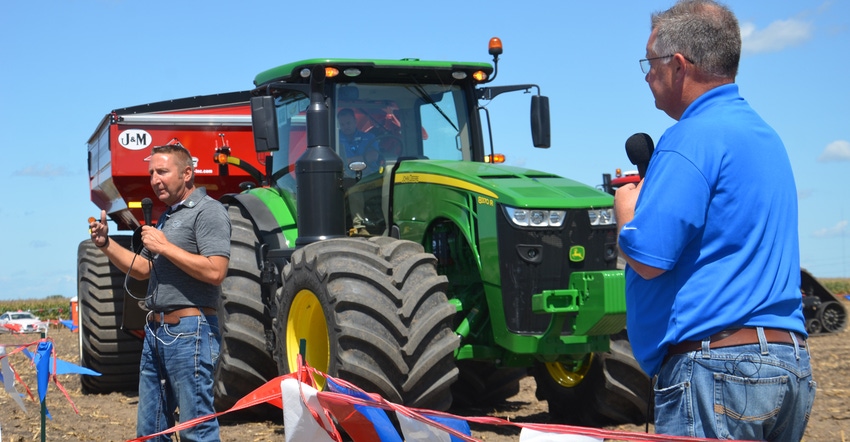
If it’s new and innovative for agriculture, Chad Colby likes to take a peek for himself. Colby, Goodfield, Ill., farms and operates Colby Ag Tech. Part of his business is testing out new technologies, and then telling other farmers what he finds through social media, his website and at field days.
Recently, Colby joined Scott Sloan, product manager of farm tires for Titan, to host a tire rodeo in the Ride ’n’ Drive area at the Farm Progress Show near Decatur, Ill. Colby and Sloan discussed the evolution of low sidewall tire technology as various pieces of equipment — tractors, tractors pulling grain carts and even sprayers — drove by, most equipped with LSW tires.
Sloan said the first prototype for these tires, which feature lower sidewalls than typical ag tires, dates back to 1997. Colby began looking at the tires several years ago.
“We’ve fought with fluid in tires and adding weights over the years, and we’ve tried flotation tires,” Colby told the crowd. “LSW tires do a lot of things we’ve tried to accomplish other ways.”
He noted that today, original equipment manufacturing companies of every color offer LSW tires on at least some new machines in their lineups. He believes that says a lot about the success of the technology.
Another option
Until LSW technology became more commonplace, your options for carrying big loads on big machinery were either duals or tracks. LSW tires offer a third alternative, Colby said.
Standing in front of a tractor pulling a grain cart, both equipped with LSW tires instead of duals or tracks, Colby noted that compared to duals, you can achieve a 20% bigger footprint with these single tires. “You’re spreading out the weight of that 34,000-pound tractor over more area with these tires,” he said. “Remember that the bulk of soil compaction happens on the first pass across the field.”
Over the past several years, some people have opted for tractors with tracks — either on the rear only or on both front and rear — to help spread the footprint and reduce chances for creating significant soil compaction. Colby sees advantages to a tractor equipped with LSW tires versus tracks all the way around and believes it’s one reason why you can expect to see more equipment with LSW tires in the field in the future.
You can equip a tractor with LSW tires for significantly less cost than tracks, Colby contends. Maintenance requirements over time are also higher for tracks compared to LSW tires.
“You also get a smoother ride with tires,” Colby said. “In fact, you get a good ride when you’re going from field to field. That’s an important consideration today.”
LSW tire technology isn’t reserved for 34,000-pound tractors and grain carts carrying 1,100 bushels or more, he said. These tires are also appearing on much smaller tractors. Look for them to show up on even more tractors and implements in the future, Colby concluded.
About the Author(s)
You May Also Like




